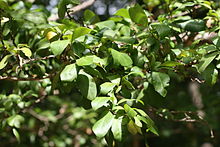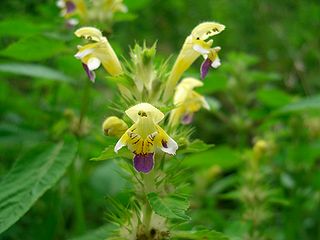
The order Lamiales are an order in the asterid group of dicotyledonous flowering plants. It includes about 23,810 species, 1,059 genera, and is divided into about 25 families. These families include Acanthaceae, Bignoniaceae, Byblidaceae, Calceolariaceae, Carlemanniaceae, Gesneriaceae, Lamiaceae, Lentibulariaceae, Linderniaceae, Martyniaceae, Mazaceae, Oleaceae, Orobanchaceae, Paulowniaceae, Pedaliaceae, Peltantheraceae, Phrymaceae, Plantaginaceae, Plocospermataceae, Schlegeliaceae, Scrophulariaceae, Stilbaceae, Tetrachondraceae, Thomandersiaceae, Verbenaceae.

Erigeron is a large genus of plants in the composite family (Asteraceae). It is placed in the tribe Astereae and is closely related to the Old World asters (Aster) and the true daisies (Bellis). The genus has a cosmopolitan distribution, but the highest diversity occurs in North America.
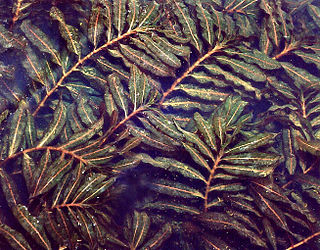
The Potamogetonaceae, commonly referred to as the pondweed family, is an aquatic family of monocotyledonous flowering plants. The roughly 110 known species are divided over six genera. The largest genus in the family by far is Potamogeton, which contains about 100 species.
The flora and fauna of Chennai are the plants and animals in Chennai, India.

Trigonostemon is a plant genus of the family Euphorbiaceae and the sole member of its tribe (Trigonostemoneae). It was first described as a genus in 1826. It is native to Southeast Asia, southern China, the Indian Subcontinent, Queensland, and a few islands in the western Pacific.

Tritaxis is a genus of plants under the family Euphorbiaceae first described as a genus in 1858. It is native to Southeast Asia, including parts of India, Sri Lanka, China Hainan, else into Philippines New Guinea, and Northern Austrailia (Queensland). Until recently, many species were listed under the genus Dimorphocalyx, first described as a genus several years later in 1861.

Ruppia, also known as the widgeonweeds, ditch grasses or widgeon grass, is the only extant genus in the family Ruppiaceae, with eight known species. These are aquatic plants widespread over much of the world. The genus name honours Heinrich Bernhard Rupp, a German botanist (1688–1719). They are widespread outside of frigid zones and the tropics.

Flagellaria is the sole genus in the flowering plant family Flagellariaceae with only five species. The family has historically been recognized by few taxonomists. The APG II system, of 2003, does recognize such a family, and assigns it to the order Poales in the clade commelinids, in the monocots.
Biblical gardens are cultivated collections of plants that are named in the Bible. They are a type of theme garden that botanical gardens, public parks, and private gardeners maintain. They are grown in many parts of the world, with many examples far from the Levant, including the Seinan Gakuin University Biblical Botanical Garden in Fukoka, Japan, and the Missouri Botanical Garden in St. Louis, Missouri, in the United States.

Butomus is the only known genus in the plant family Butomaceae, native to Europe and Asia. It is considered invasive in some parts of the United States.

Renosterveld is a term used for one of the major plant communities and vegetation types of the Cape Floristic Region which is located in southwestern and southeastern South Africa, in southernmost Africa. It is an ecoregion of the Mediterranean forests, woodlands, and scrub biome.

The flora of China consists of a diverse range of plant species including over 39,000 vascular plants, 27,000 species of fungi and 3000 species of bryophytes. More than 30,000 plant species are native to China, representing nearly one-eighth of the world's total plant species, including thousands found nowhere else on Earth. China's land, extending over 9.6 million km, contains a variety of ecosystems and climates for plants to grow in. Some of the main climates include shores, tropical and subtropical forests, deserts, elevated plateaus and mountains. The events of the continental drift and early Paleozoic Caledonian movement also play a part in creating climatic and geographical diversity resulting in high levels of endemic vascular flora. These landscapes provide different ecosystems and climates for plants to grow in, creating a wide variety of different flora spanning over not just China, but different parts of the world.
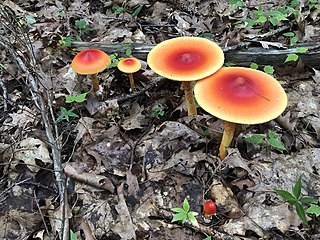
Amanita jacksonii, also known as Jackson's slender amanita, American Slender Caesar, and Eastern Caesar's Amanita, is a North American species of fungus in the family Amanitaceae. It is a reddish-orange colored mushroom species which can be identified by its yellow gills, large, white, sacklike volva.
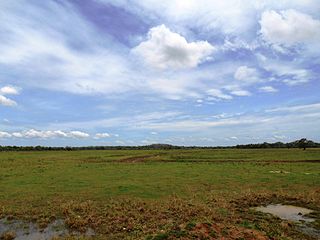
Somawathiya National Park is one of the four national parks designated under the Mahaweli River development project. Somawathiya Chaitya, a stupa said to be containing a relic of the tooth of the Buddha, is situated within the park. The park was created on 2 September 1986, having been originally designated a wildlife sanctuary on 9 August 1966. The park is home to many megaherbivores. The national park is located 266 kilometres (165 mi) north-east of Colombo.

Urticicola is a genus of air-breathing land snails, terrestrial pulmonate gastropod mollusks in the subfamily Trochulininae of the family Hygromiidae, the hairy snails and their allies.
Xyroptila vaughani is a moth of the family Pterophoridae. The species was described by Thomas Bainbrigge Fletcher in 1909. It is found in Sri Lanka and India.
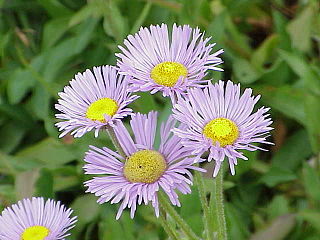
Erigeron glabellus is a North American species of flowering plants in the family Asteraceae, called the streamside fleabane.
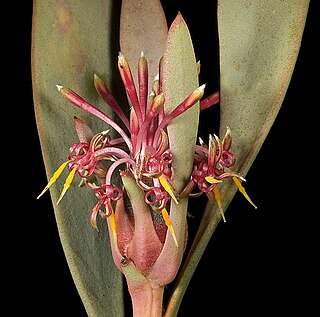
Isopogon pruinosus is a species of flowering plant in the family Proteaceae and is endemic to southwestern Western Australia. It is a compact, spreading shrub with narrow egg-shaped leaves with the narrower end towards the base and spherical to elliptic heads of pink flowers.

Leucopogon glabellus is a species of flowering plant in the family Ericaceae and is endemic to the south-west of Western Australia. It is an erect, glabrous shrub with slender branchlets, heart-shaped to lance-shaped leaves, and cylindrical spikes of white flowers.
Phaseolus glabellus is a species of flowering plant in the genus Phaseolus. It is native to Mexico, with red flowers.
